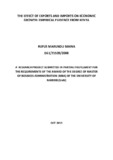| dc.description.abstract | The main objective of the study was to investigate the relationship between exports, imports
and economic growth in Kenya. The study was guided by the following specific objectives:
To examine the relationship between exports, imports and economic growth: This will be
determined by establishing whether a correlation of any nature exists and to examine the
strength of the relationship, if any, between exports, imports and economic growth. The type
of research design that employed in this study is co-relational research design. The target
population relevant to the study was GDP, imports and exports as measured in terms of
dollars for the period 1960 to 2010. The study employed secondary data collection.
Correlation analysis was employed.
The findings revealed that exports led to economic growth. There was a strong positive or
direct relationship between the exports and the economic growth. However, the correlation
coefficient exports and economic growth compared to the correlation between the imports
and economic growth was slightly small. For this case, it would mean that imports had a
greater impact than exports on economic development in Kenya. Also, the findings indicated
that there was a strong positive or direct relationship between the imports and the economic
growth in the country. It was easy to conclude that that the association is very strong as
compared to exports. This may be attributed by the imports of capital goods main in the
agriculture, industry and transport sector.
The study recommends that the country should apply both the Export Led Growth hypothesis,
and the Import Led Growth hypothesis, although the latter has greater impact in Economic
growth. The study recommends that the country should continually import capital goods to
increase the growth of the economy in the country thereby raising domestic output in key
areas of the economy such as agriculture, industry, and transport and Infrastructure to lead to
economic growth. Capital goods also increases the efficiency of labor by reducing time spent
on production and hence raises production, in turn leading to growth of the economy .On the
same breadth, investment in export sectors such as Tourism, Horticulture and Minerals is also important and must be continually encouraged. | en_US |

